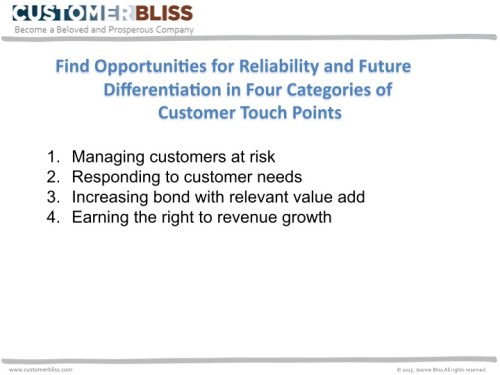
Experience reliability is hard to achieve. The root cause of this lies firmly in the fact that there is no reliability in how to do this work. The selection and improvement approaches vary by silo and leader priority. In most companies, a deeply rooted one-company approach to caring about (and improving) customer experiences and customer lives does not exist.
When we begin this work, most organizations haven’t evaluated the reliability of the experience delivered across the entire customer journey. Most are inadvertently delivering a random experience to customers for a number of reasons which we have discussed before:
- Silos have distinct priorities and metrics.
- Leaders don’t unite to build end-to-end priority experiences.
- Issue resolution is mostly by silo, driven by survey score reactions.
At the beginning of this work, I often do a reality check with clients, asking them to rate the stages of their customer experience. The question is simple: ‘In this stage of your customer’s journey, is the experience you deliver consistent and reliable?’ Most often the answer is, ‘It depends.’ That is the Achilles heel of your experience. It gets in the way of growth and profitability, and is why you need to get leaders to care about what causes the ‘It depends’ experience.
Guided by your journey framework, think of opportunities for reliability and future differentiation in four categories of critical touch points:
- Managing customers at risk
- Responding to customer needs
- Increasing bond with relevant value add
- Earning the right to revenue growth
These are the moments that will impact your growth. Failure to perform at any point will disappoint customers. These intersection points along your customer journey impact customers’ evaluation of value delivered. They drive decisions to stay, leave, buy more and recommend you to others. To earn the right to customer asset growth, customer touch points require consistency in how they are executed across the channels, the silos, and your business.




When Jill Griffin and I wrote “Customer WinBack” a decade-and-a-half ago, we defined seven stages that make up the customer life cycle. Risk, we determined, was probably the most important stage, because, if not quickly turned around, risk begins the slippery slope that leads to (voluntary) customer defection. Having processes and protocols in place to mitigate or eliminate identified risk is one of the best investments any company can make. The other three reliability opportunities you’ve identified in the post all depend on the organization maintaining a close enough relationship with the customer that perceived value is always the most essential consideration.